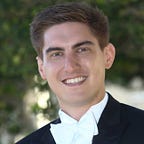#2 Words Matter
“The realm of fairy-story is wide and deep and high and filled with many things: all manner of beasts and birds are found there; shoreless seas and stars uncounted; beauty that is an enchantment, and an ever-present peril; both joy and sorrow sharp as swords. In that realm a man may, perhaps, count himself fortunate to have wandered, but its very richness and strangeness tie the tongue of the traveller who would report them. And while he is there it is dangerous for him to ask too many questions, lest the gate should be shut and the keys be lost.”
- JRR Tolkien, “On Fairy-stories”, paragraph 2
If you have ever enjoyed a book series, TV series, movie trilogy, or another sort of media, you understand and appreciate the details that make for consistent world-building, storylines, and character development. Maybe you love the development of Tony Stark throughout the MCU as a brash billionaire to a caring mentor, or the growing confidence of Neville Longbottom throughout the Harry Potter series. Perhaps you love the concept of the Multiverse, and the ‘What If…?’ show answering questions we didn’t even know we had. Maybe you connect with characters most when they are vulnerable, fallible, or suffer from loss and grief. If you are like me, you love being transported to another world that is simultaneously our own (but not at all).
If any of these things resonate with you, I encourage you to dip your toes into the mythos of JRR Tolkien.
In choral music, many of us strive to ennoble our singers and audiences, that is, to lift them up to a higher place. This can happen both within the context of a performance, but also in our daily lives. What lessons and ideals can we take from the words of the Mass, or from John Muir, or Amanda Gorman? As singers, we must love poetry both for its music, and its lessons. I want to show you the care and craft Tolkien has put into his words, which are just as important as the wonderfully rich and detailed world he created.
An anecdote about Tolkien:
John Ronald Reuel Tolkien wrote his first story aged seven. It was about a “green great dragon.” He showed it to his mother who told him that you absolutely couldn’t have a green great dragon, and that it had to be a great green one instead. -The Elements of Eloquence (Mark Forsyth)
Tolkien realized that before he could write stories, he needed to become a master of language and words. Indeed he did, and he had a successful career as a college professor, taught courses in Old English, Middle English, Gothic, Old Icelandic, and Medieval Welsh, and was familiar with Finnish, Old Norse, and Latin. The dude definitely knew a little bit about languages. Meanwhile, I can’t even do a decent posh accent or speak anything besides American.
All of this to say, the various songs and poems in his stories have the utmost thought and care put into them. The music is a part of the words. “The Road Goes Ever On” simply leaps off the page into song; “Where is the Horse and the Rider” is hauntingly deep and dirge-like.
That brings us to his constructed languages, or my technical term, ‘made up.’
We sing in all kinds of languages, even though we are hardly fluent in more than one. Maybe two. Luckily, Tolkien’s snippets of conlang are not only incredibly crafted, adhering to his own rules of syntax, tense subject-verb agreement, blah blah blah……they are quite simple to pronounce, especially with the use of IPA that we all know and love. Syllabic stress is intuitive and not unlike Latin which we spend hours perfecting with our choirs. (Insert joke about church choirs and ‘alleluYAH’).
I want to briefly mention that there already exists excellent scholarship by Richard (Garry) Leonberger (DMA, Louisiana State University). See ‘Chapter 4: Elvish Lyric Diction’ of his dissertation, ‘A Swann’s Song in Middle-Earth.’ Now if you just made a face because you are astounded there is actual doctoral scholarship on an actually published song cycle based on Tolkien…..yes, we nerds are out here. With citations and IPA. Garry is a wonderfully accomplished Tenor, and you can find his lecture recital on the Youtube. Huge thanks to him and his work for inspiring me and feeding my obsession.
The takeaway for composers: There aren’t a lot of roadblocks to setting Tolkien’s poems, including the elvish languages. There is a music inherent to his words because he was a scholar of language. Choir directors: We can teach our choirs to differentiate Ecclesiastical Latin from Germanic Latin, and discern different tonal colors from sacred harp to bel canto. So to can we easily navigate the languages of Quenya (Latin elvish) and Sindarin (vernacular elvish).
The ‘technical stuff’ of language is not a barrier to composition. As I wrote before, the music is inherent to the language; it simply leaps off the page. When combined with the story context of each poem, you can see the potential to ennoble and enchant both choirs and audiences.
Actual example: Here is a recording of Professor Tolkien reciting a poem in Quenya. This is a song sung by Galadriel, the Lady of the woodland kingdom of Lothlorien. My next post will focus on this particular text. Happy listening!
J.R.R. Tolkien recites “Namárië” (Galadriel’s lament) — YouTube
